#calusa indians
Text
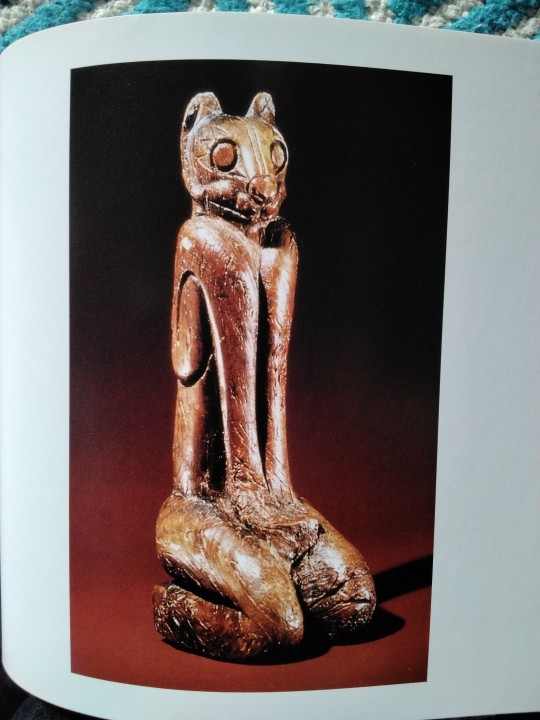
Key Marco cat, c.1600s.
Region: Florida.
This tribal representation of a kneeling cougar was part of an extraordinary archaeological find on Marco Island in 1896. This area of south-west Florida was originally populated by the Calusa Indians – hunter-gatherers who are known to have been fierce warriors. They fished in the estuaries and have been dubbed ‘The Shell People’ because of the great mounds of shells that have also been found here. They were scattered and disappeared soon after the Spanish explorers came to the area.
The Calusa were skilled artisans, and more than 1,000 pieces were discovered at the Key Marco site at the northern tip of the island, including masks and weapons, ceramics, bone and shell artefacts, some of which date back to the sixth century CE. The site was discovered by Captain W. D. Collier and excavated by Frank Hamilton Cushing. Dating from the seventeenth century, the cat is about 15cm (6 in) high and is in remarkably good condition. It is carved from wood and represents a feline/human figure. The anaerobic properties of the mud had preserved it for centuries.
Source: ‘Folk Art’, Susann Linn-Williams, pp. 154-55.
#Native American#traditional crafts#Marco Island#Florida#Calusa tribe#The Shell People#shells#Captain W D Collier#Frank Hamilton Cushing#folk art
3 notes
·
View notes
Text
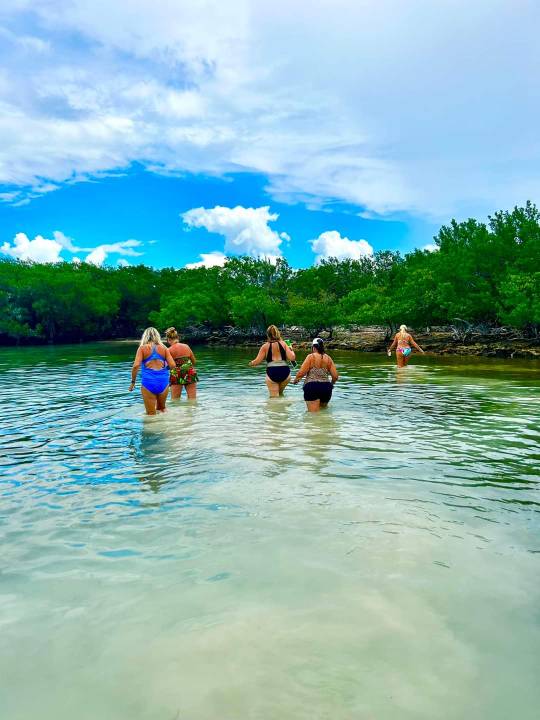
Wade up with Capt Rob and explore Indian Key. Abandoned in the 1840’s this tiny Island was once the 2nd wealthiest community in the United States. Ruins of the city still exist 200 years later. Just one stop of the day among many.
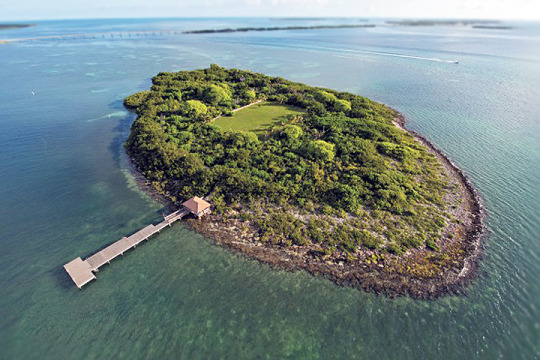
History
Native Americans began visiting and living on Indian Key around A.D. 800, and were likely a submissive tribe to either the Tequesta or Calusa chiefdoms, however, the exact nature of the relationship between the Keys Indians and these other groups has yet to be defined. Of interesting note is the fact that even in the 1840s and 50s, the Indians around the Keys were called "Spanish Speaking Indians" and not identified as Seminole of Miccosukee.
0 notes
Text
Downtown Fort Myers' "Allure Your Senses" Sculpture Analysis - Nestor Mendez

(The first sculpture is about 4 feet tall, with a width and length of 5 feet)
What you are looking at right here is one out of 23 wonderfully sculpted statues found in Downtown Fort Myers called "Allure Your Sense". The sculptor of this piece goes by the name of Edgardo Carmona, and they made their debut on January 7th, 2016. The initial motive for commissioning these works were for an exhibit. As the sculptures started to gain traction, the public soon wanted to keep them, and they were bought for $55,000 dollars to be a staple of Downtown Fort Myers.
This sculpture main purpose of this sculpture is to preserve the history of the Calusa Indians. Carmona treasures history, and he wanted to represent the struggles of the city in its initial stages. The community values these pieces of art because they are hot spots for socializing and can even spark a conversation. This sculpture resonates in the mind of many citizens because they are found in the same streets the amazing men like Thomas Edison and Henry Ford walked; in fact, this very same work of art can be found outside of the restaurant "Ford's Garage".

(The second is about 19ft tall, has a width and length of about 4ft including the base)
As you look at these next few pictures of two more sculptures from the "Allure Your Sense", you can really start to notice a pattern between them, and why the sculpture chose it to be this way. The surrounding area you see the rest of these sculptures and they are all performing some sort of act, or form of entertainment. Carmona's drive to preserve history led me to believe that the Calusa Indias where very optimistic and playful even in the mist of their situation. x

(The third sculpture is about 4ft tall, and was a width of about 6ft and a length of about 4ft)
0 notes
Text
16th Century Settlements - Florida Department of State
When European ships first landed on Florida in the 16th century, the area was well populated. Indians of the Timucua, Apalachee, Ais, Tekesta and Calusa were farming rich lands in the north -- growing corn, beans and squash -- and fishing or hunting for most of their food in the south.
0 notes
Text
Books by Clint Bennett: The Jesuit Warrior and Jason the Slave Warrior
Clint Bennett, Award-winning Author
A fourth-generation Floridian, whose family lived and thrived in the southern part of the Okefenokee swamp near Jasper, Florida, Clint Bennett was born in Dunedin, Florida and moved to Homosassa in 1976.
During four years in the U.S. Navy, he had the opportunity to tour the countries bordering the Mediterranean. Spain was one of his favorite ports of call. Up from the port was a Jesuit monastery, and Clint met and befriended several Spanish Jesuits, learning about their culture and history, especially the horrors of the Spanish Inquisition.
Three topics have always fascinated Clint: the horrendous suffering of the Europeans during the Inquisition, the impact the indigenous tribes of Florida by the arrival of Europeans, and the life and culture of the west Central Florida indigenous populations.
The Jesuit Warrior
After retiring from his professional writing job in 2000, Clint seriously researched and studied the Nature Coast area’s indigenous culture to begin creating his first novel, “The Jesuit Warrior,” a work of historical fiction that tells the story of a disillusioned Jesuit student living in Valencia, Spain during the Spanish Inquisition.
After witnessing a personal horror that causes him to question the teachings and agenda of the Jesuit priests, he boards a ship that will deliver slaves to central Florida. He is captured by the native people in Crystal River. Using his Jesuit medical training as an asset, he becomes a member of the Calusa village, eventually helping them survive attacks by the French and Spanish slavers.
Set in the Nature Coast, from Aripeka to Steinhatchee, including Crystal River and Homosassa, the novel is a wonderful work of historic fiction that grips the reader and teaches about the Calusa, the Timuc and the Appalachia Indian tribes that once thrived on west central Florida’s shores.
There are five-star reviews of his work on Amazon, Barnes and Nobel and other retailers.
Jason, The Slave Warrior
Next, Clint wrote, “Jason the Slave Warrior,” which begins in New Orleans, and is the story of a young slave and his wife who escape their masters during a hurricane. They steal a sailboat, heading for “a place in central Florida where the slavers are afraid to go.” The two make their way to crystal River, where they are welcomed into the Calusa tribe as honored members. Martha is a renown healer, and Jason a welcome translator and who becomes a valued warrior. The geographical setting for the book is primarily Crystal River, the Homosassa River, Steinhatchee north to Deckle – and south to Tampa, Florida. The Calusa, the Timuca, and the Appalachia Indian tribes and their culture are heavily described in this gripping historical fiction novel.
After ordering one, or both, of these novels, email Clint by clicking here to make arrangements for him to autograph your copy.
More About the Author, Clint Bennett
“I was born in Dunedin, Florida in 1945 and have fished and explored the waterways from Dunedin to Steinhatchee since I was old enough and strong enough to hold a paddle, a set of oars, or operate an outboard motor. I have canoed, camped, and explored most of the Suwannee River from the Okefenokee Swamp to Branford, Florida. Today I live in Crystal River, Florida with my wife and we continue to fish and explore the areas described in my books. I will gladly sign and personalize copies of my books,” Clint explains.
"During four years in the U.S. Navy, I had the opportunity of tour the countries bordering the Mediterranean Sea. Spain was one of my favorite ports of call. The squalid conditions in Spain during the early 18th century are accurate as described. My experiences in Europe helped to further my interest and research into the Spanish Inquisition and the numerous diseases and plagues that so devastated Europe for centires. I have also spent time in South Africa where I became interested in the horrors experience by the slaves and the savagery of their captors."
Read the full article
0 notes
Text
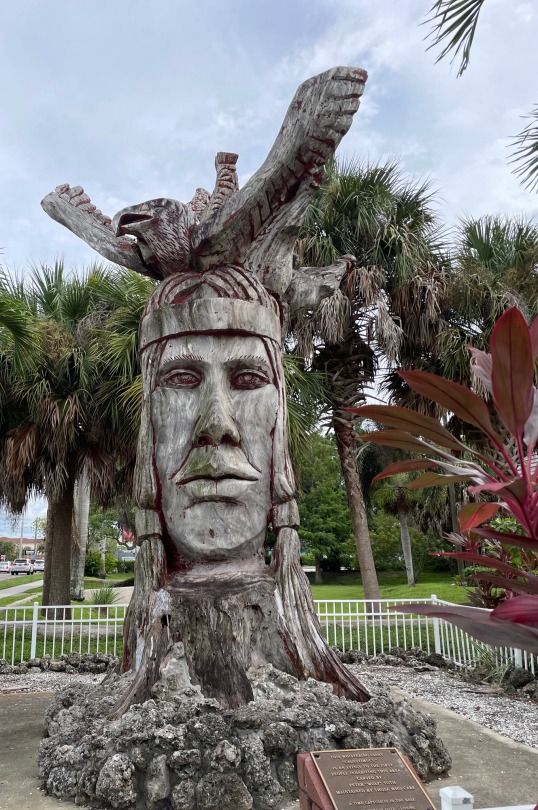
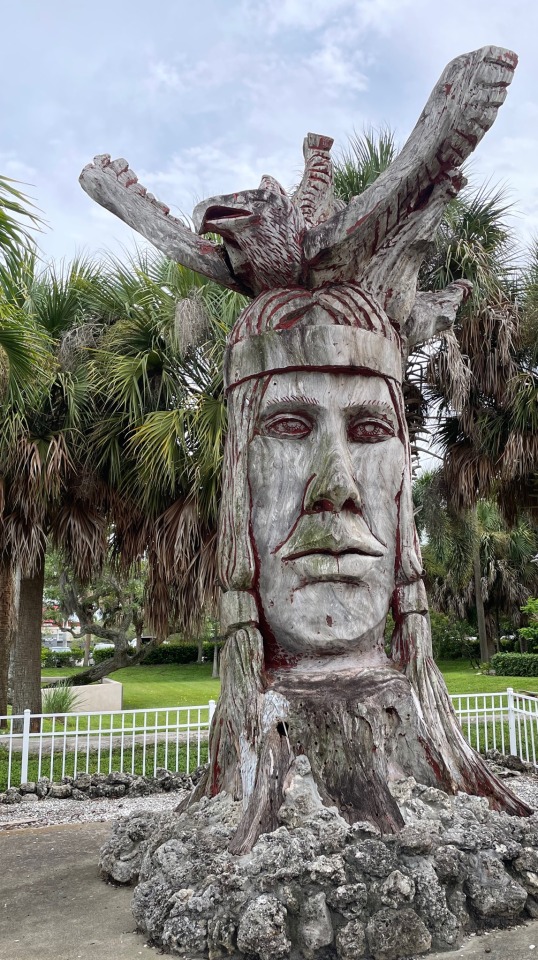
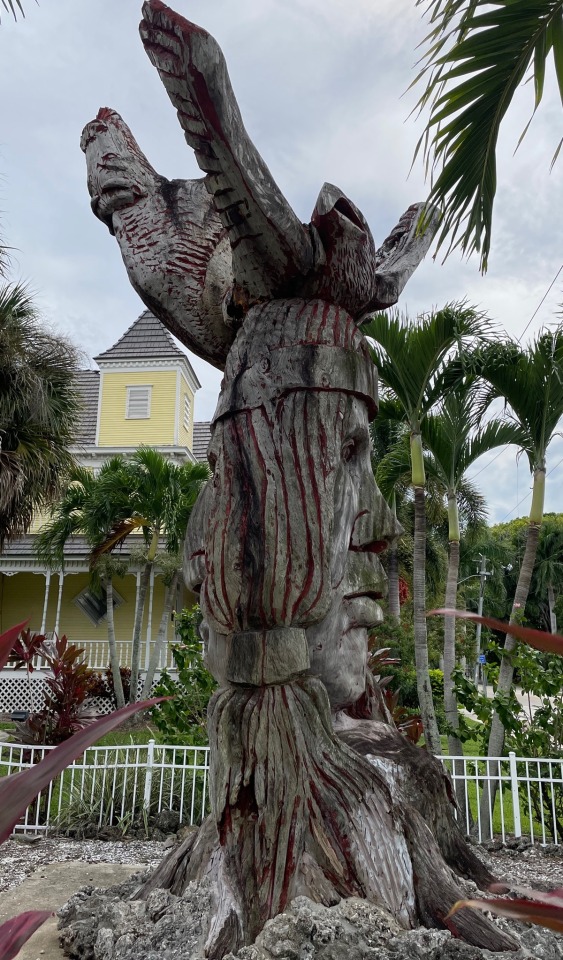
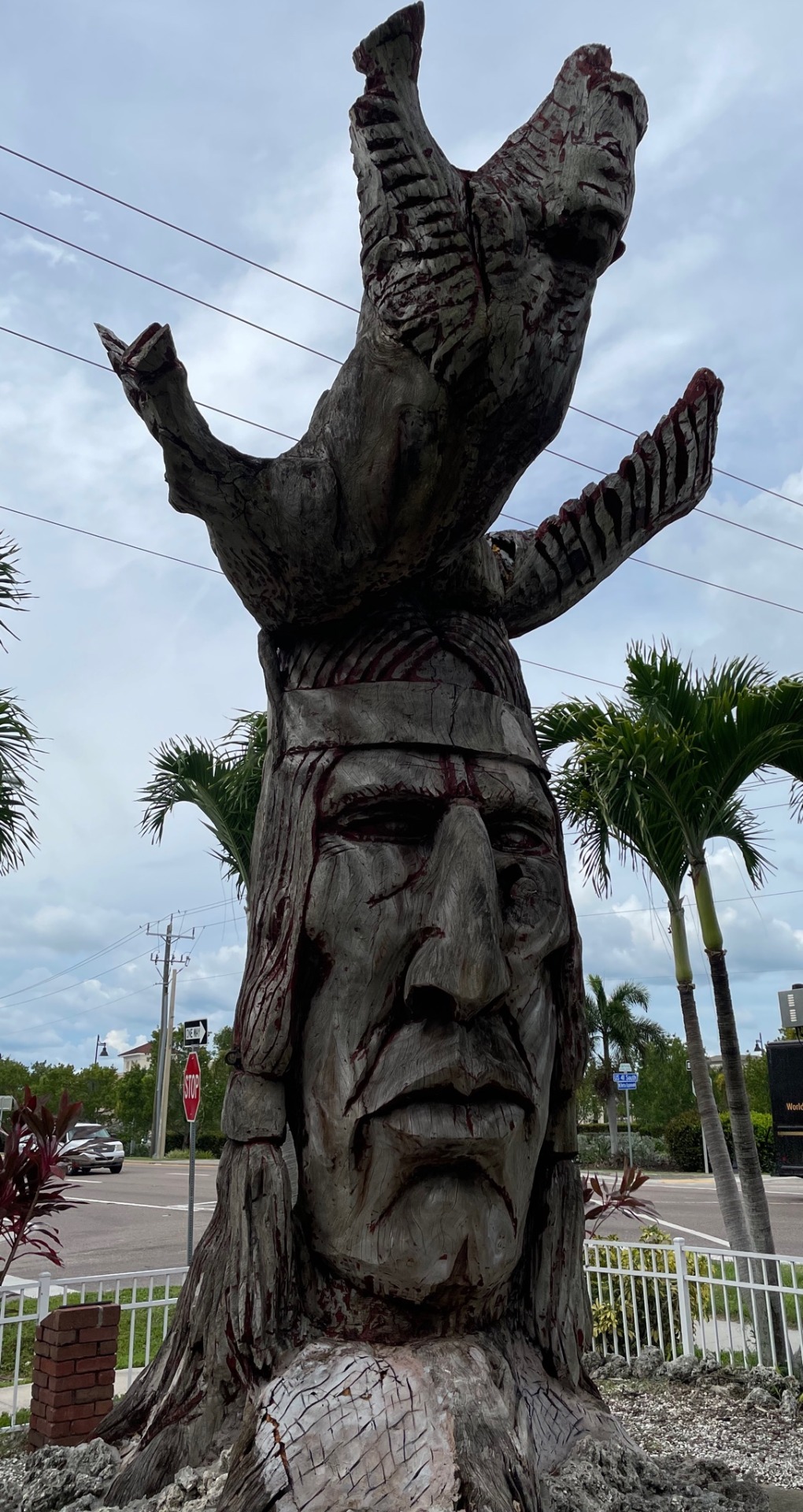
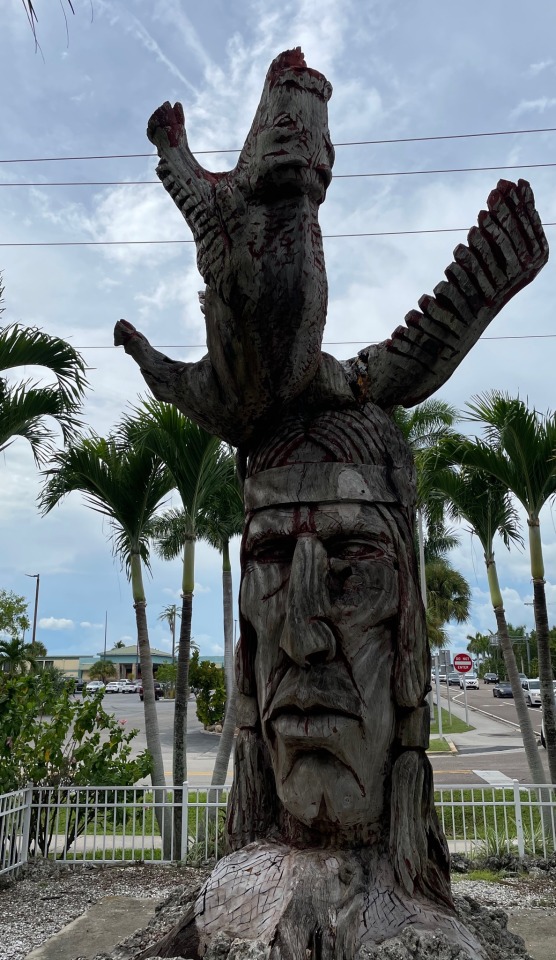
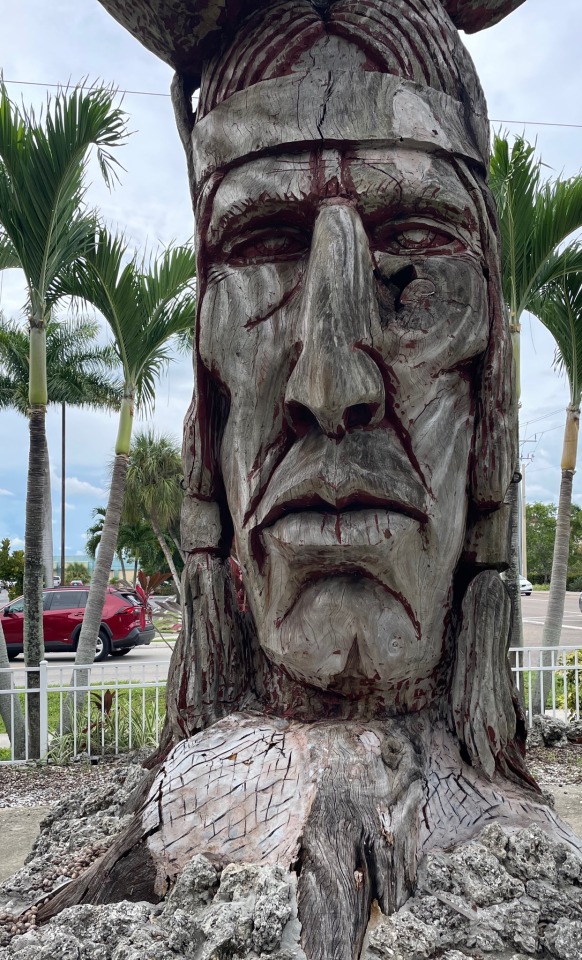

Calostimucu is a twenty-foot-tall statue carved in the round by Peter “Wolf” Toth. The fascinating story began in the seventies when Fred Babcock discovered a very large, dead monkey pod tree on his property overlooking the Charlotte Harbor in Southwest Florida. Fred Babcock had become aware of and impressed by, the sculpting talent of Peter “Wolf” Toth during a visit to La Jolla, California in 1972. La Jolla was the site where Toth had created his first massive sculpture of an Indian head. It was during his work on the cliff-carved stoned visage that he formulated his plan to shape a “Whispering Giant” Indian head in every state of the United States. Toth’s next stop was his “hometown” of Akron, Ohio where he elected to transition to sculpting in wood for the remainder of his series. Peter “Wolf” Toth was not born in Akron; his family fled Hungary in 1956 to escape Soviet occupation. Toth was captivated by the American Indians and sympathized with their mistreatment and oppression. He is quoted by Roadtrip America as explaining, “This (the statue) is my concept of the Indians of this area. I study the Indians of the area, then visualize an Indian within the log. It is a composite of all the native people of the state.” (Thurman 2010) Which perfectly mirrors what he achieved in Punta Gorda, FL.
Calostimucu is a composite of the Calusa and Timucua that were prevalent in this area prior to white expansion. Calostimucu is the tenth statue completed in Toth’s “Whispering Giant” campaign. It is unique in the dual nature of the round. It has two faces and two symbolic animals jutting from the crown. The face confronting all Southbound traffic on US 41 is that of a maiden. She looms, at twenty feet, stoic in the deep hewn lines bracketing her mouth with expressive deep-set eyes. She has a generous mouth situated above a squared jaw in an elongated face. Twin braids conceal her ears with an eagle positioned along the part in her hair. The eagle appears to be in distress: either falling from the sky or failing to gain flight. Opposite the maiden is the Chief. He strikes me as resigned in anger. The deep lines of his face and lips are emphasized by lingering red paint that has all but worn off the superficial exteriors of the monkey pod. I have attempted to capture what I found to be a compelling feature of the chief’s face. Toth chose to allow the natural grain of a burl to act as the undereye pad of Calostimucu’s male left eye. Knots in trees occur as branches are severed, or broken, from the living tree. The burl in the wood is a remnant of a lost limb, a scar, but also proof of the tree’s survival. I doubt that its inclusion was accidental. At the base of the figures are roots that Toth took pains to crosshatch, effectively concealing the wood’s grain. Juxtaposed on the opposed eye is a slash that draws further attention to the organic knot. The overall impression is of a man bruised and angry, calmly planning his next move. The animal form projecting from the Chief’s head is a buffalo. It is stationed on its back, clearly in distress, with four legs clawing at the sky. This corroborates the predicament of the eagle.
I grew up with this statue at the foot of Charlotte Harbor bridge. I remember waiting to see the Chief’s face as I crested the peak. I do not remember if I ever saw it covered in red paint. The reason that I chose this work is that it has always spoken to me. Whispering about rage and self-control. The property that Calostimucu originally stood on was severely damaged in Hurricane Charley. As the decision to relocate the statue was being considered in Charlotte County, there was a controversy concerning the composition of the figures that I had never considered. Citizens were disturbed by the buffalo’s anatomical correctness. I found the rank pettiness deeply offensive and had not been to visit my old friend since his face was turned away. I am extremely grateful to have had this incentive to revisit Calostimucu and am proud that it still remains. For me, Calostimucu epitomizes the community it resides in. Citizens appreciate the artistry and even some of the history. But they don’t want to look it full in the face. They prefer to turn away and pretend that something obvious, true, and essential isn’t there.
Thurman, G. (2010, October). Sculpture by peter wolf toth in winslow, arizona. Peter Toth sculpture in Winslow, Arizona. Retrieved September 17, 2022, from https://www.roadtripamerica.com/roadside/Peter-Wolf-Toth.htm
1 note
·
View note
Text
Journal 7 - Based on Field Trip 5 - Marine Studies Virtual Field Trip
Fort Myers Beach is a breathtaking Florida Beach. My colloquium class took a virtual field trip to Estero Island. I grew up in fort Myers. For most of my life, Fort Myers beach was a spot I frequently visited. The beach is quite beautiful and there are many different things to see. The houses and shops are all so colorful. Once you arrive at the beach, you'll be captivated by the breathtaking scenery.
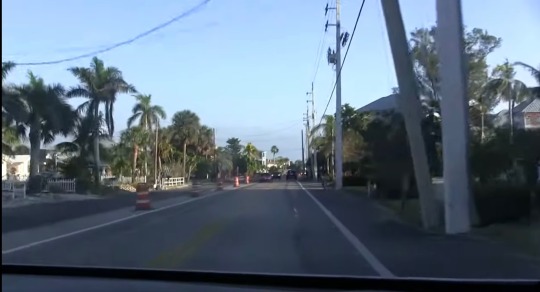
The tour was led by Mrs.Hughes, a long-time resident of the island and a member of the Estero Island Historic society. She told us stories of what it was like growing up on the island. I learned that the population when she was a child was only a few hundred and currently it is between six to seven thousand year around. Although during the winter its becomes 50-60 thousand.
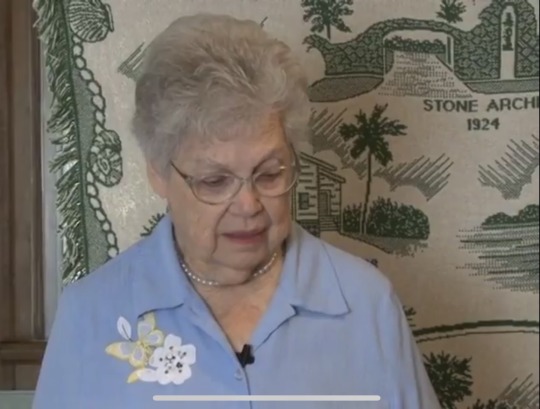
There were several original groups that settled in the area. Mrs. Hughes talked about the Calusa Indians and how they inhabited the island over 2,000 years ago. They constructed shell mounds along the bayside of the island. The Calusa met their demise when the Spanish came and took over. There was essentially a massacre that occured. The names Matanzas presevere and matanzas pass bridge come from that battle. Matanzas means massacre in Spanish. This is why you will see Spanish names all around the state due to the influence that they had.
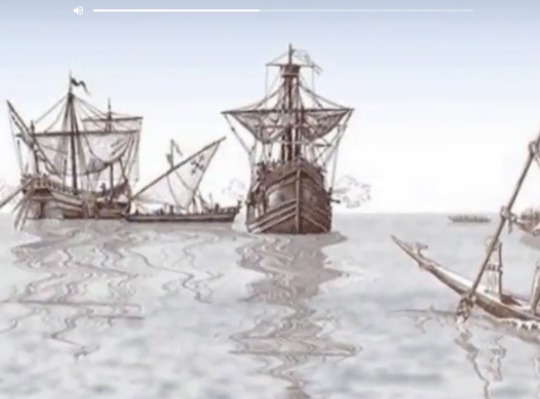
Fort myers beach was primarily a fishing village and it eventually transitioned into a tourist destination. We learned about the popular mullet fish. Many people used nets to catch these fish and would sell them to fish houses. Net fishing was eventually banned by the entire state and that's when the shift began. On top of that, their food source was taken away when the scallop's habitat was destroyed. Fort Myers beach has since begun to take proper steps to promote sustainability. Along with beach nourishment, a terminal groin was built on the south side of the Matanzas pass. The pass is a federally maintained channel that requires maintenance every three years Officials have taken the proper steps to have a healthy beach.
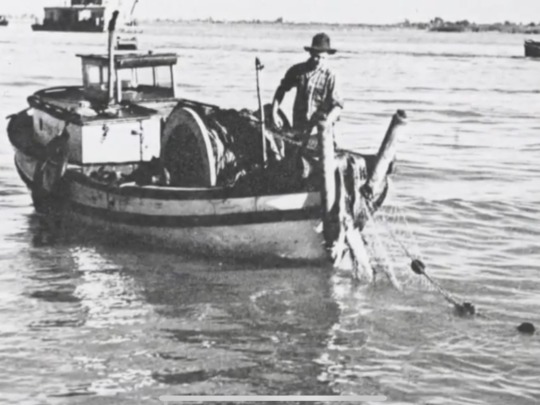
1 note
·
View note
Text
In Search of the Calusa 3
In Search of the Calusa 3
About Randell Research Center, Pine Island, Lee County, FL -an extension of the University of Florida, both Ed and my alma-mater.
This post will be my final post in a series entitled “In search of the Calusa.” Today is number 3. You may have already read 1 & 2.
In Search of the Calusa 1
In Search of the Calusa 2
Pine Island’s Randell Reaserch Center was the perfect place to end Ed and my west…
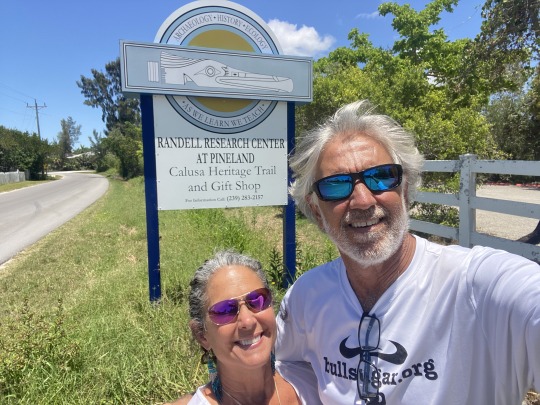
View On WordPress
#CALUSA#Calusa 3#Calusa Indians#Calusa shell mounds#History of the Calusa Indians#how do I learn about the Calusa#In Search of the Calusa 3#learning about the Calusa#Pine Island#Randell Reseach Center Pine Island#Randell Research Center
0 notes
Text
Pineland dig yields rare Calusa artifacts
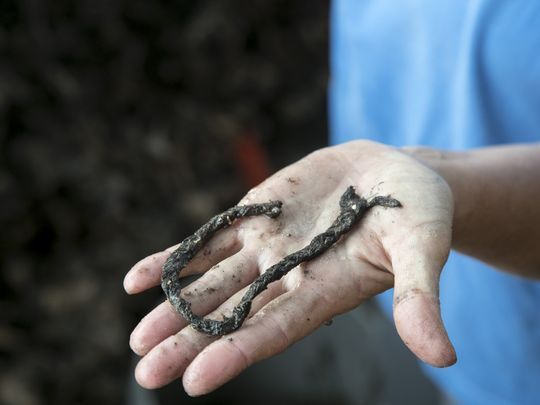
There's a reason you won't catch most local fishermen using anything but synthetic nets: Saltwater and subtropics are brutal on natural fiber, rotting it to frayed pulp in one scant season.
Which is what makes a bunch of newly filled zip-lock bags exciting to an archaeological team that's spent the last couple weeks painstakingly digging on Pine Island: They're full of thousand-year-old Calusa Indian rope, net and twine, among other finds.
No one has seen remnants of ancient daily life like this since the 1800s, when a Smithsonian expedition led by pioneering anthropologist Frank Hamilton Cushing unearthed more than 1,000 remarkably well-preserved artifacts, including the celebrated Key Marco cat near Marco Island. Read more.
82 notes
·
View notes
Photo




At the Calusa Mounds!
#calusa#indigenous#native american#american indian#midden#shell midden#pine island#florida#sacred#pre-columbian#gumbo limbo#Bursera simaruba#conch#really really old
2 notes
·
View notes
Photo
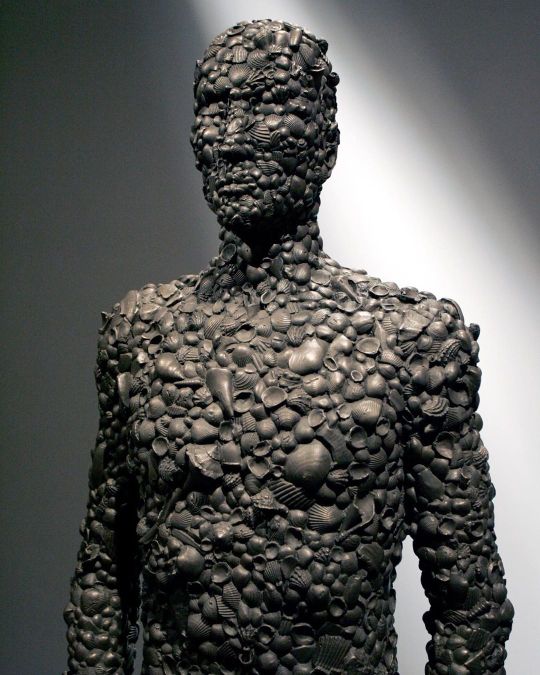
Throwback to Calusa from 2006. Bronze. Photos by Rudolf Van Dommele. The Calusa (sometimes referred to as “The Shell Indians”) were Native Americans that populated much of Florida. An eye opening wiki read. This piece was commissioned by Paul and Sue Kruder and made to remember these earlier inhabitants. It now stands at the heart of a small public park in Boca Grande, where I grew up. #sculpture #art #fineart #contemporaryart #calusa #florida #native #nativeamerican #gulfcost https://www.instagram.com/p/B-em1JglmiL/?igshid=9uinwoowfm4p
15 notes
·
View notes
Text
Avenue south residence
As if perpetually sunny skies and some of the world's most beautiful beaches weren't enough, Southwest Florida offers an abundance of shopping options for even the most discriminating buyers. Three signature landmarks illustrate the area's appeal.
Discerning shoppers have long heralded Fifth Avenue South as the perfect combination of a historic main street and world class shopping. Fifth Avenue originally served Naples' first residents, the Calusa Indians, before becoming a road in the late 1800s. Today, the avenue spans 12 blocks and 50 buildings, including the eclectic venues of Tin City, Crayton Cove, and Bayfront shopping areas. Sophisticated boutiques compete with colorful art galleries, sidewalk cafes and first class dining establishments. Elegant banyan trees overhang mini-parks and walkways to provide shade to those searching for that unique gift. At night, the avenue comes alive with theater performances by the Naples players at the Sugden Community Theater and a year-round schedule of street art shows, sidewalk sales and special events. Ample free parking is provided on the street or in a nearby lot.
The newly opened Coconut Point Town Center is considered the crown jewel for shopping in fast-growing Estero - located on the West Coast of Florida halfway between Ft. Myers and Naples. Avenue south residence As the focus for a 500-acre master planned community, Coconut Point is more than just a shopping center. The property includes 90,000 square feet of office condominiums, and residential units - all flanked by acres of lakes and meandering boardwalks. The Mediterranean architectural style compliments the 1.2 million square feet of open air retail with more than 150 stores and 15 restaurants. Anchor tenants include Dillard's, Barnes and Noble, Sports Authority, Tommy Bahama, and Ann Taylor, among others. Designed as a Main Street-style shopping destination, Coconut Point is the place for vacationers and residents alike to gather, shop, dine, work, and play. A 20-screen megaplex theater lets you be the first to enjoy the latest films in sumptuous style. Fine dining is available at Ruth's Chris Steakhouse, the Blue Water Bistro, and the Grill Room. Those with more casual tastes can enjoy a drink and appetizer at Pagatelli's Cucina on the patio or sample bison at Ted Turner's Montana Grill. The open air presentation of the restaurants allows you to enjoy your dining experience in al fresco comfort. As an added convenience, shuttles are available to pick you up and deposit you at signature destinations around the property.
Moving further North, Fort Myers is home to the Edison Mall which is recognized as the largest mall in southwest Florida. The "L" shaped layout makes it easy to find stores, such as Dillard's, Macy's, the Disney Store, and other perennial favorites. Strolling the mall's full interior is the equivalent to walking more than a mile, providing additional appeal for those looking to exercise while they shop. More than 20 eateries and 160 specialty vendors offering everything from resort wear to other Florida favorites complete the experience. New tile floors, soft seating areas, and a sparkling, renovated fountain in air-conditioned comfort provide further appeal. Edison Mall is located at the intersection of US 41 and Colonial Boulevard in Fort Myers.
1 note
·
View note
Link
Everglades National Park (Florida)
Everglades National Park is in the southern-most point within the United States. This park is known for its tropical wetlands and is infested with some of the most dangerous reptiles (alligators, cottonmouths, coral snakes, and Burmese pythons), animals (panthers, wild boars, and black bears) and insects (mosquitoes, kissing bugs, fire ants, and deadly spiders) on the planet. The Calusa Indians had called these forbidden swamplands home until the Spaniards arrived in the year 1513. It isn't just the wildlife, quicksand, and hurricanes that visitors need to worry about in this park—paranormal activity also abounds. It should come as no surprise that since the Calusa Indians lived and died in these swamps, the area is one large, watery grave.
Many people live near the Everglades. In 1969, a fourteen-year-old boy and his family lived next to the park, and the boy loved to explore the swamps. One day he stumbled upon an old grave that held the remains of one of the area's original inhabitants, a Native American. The remains had been buried with a gold medallion, and the boy decided to removed the necklace from the skeleton and take it home with him. Soon after the medallion entered the home, the family began to suffer from terrifying nightmares. Then, the once-happy young boy committed suicide by hanging himself. The family believed that when the boy took the medallion from the grave, he unleashed a deadly curse. However, instead of returning the medallion back to its original burial spot, the family sold it. Every person who owned it after the young boy fell to its curse. It is unknown where the medallion is today.
Ed Watson was known to his neighbors as Bloody Ed. In 1896, Ed Watson (known to his neighbors as, "Bloody Ed") moved onto Chokoloskee Island in the Everglades to start a sugarcane plantation. His neighbors stayed far away from him, as Watson was not a friendly man. Case in point: one day, two men were squatting on one of the islands, called Lost Key. Watson did not own this island, but he still killed the men for trespassing. To run his sugarcane crop, Watson would find workers, but would only hire people that were not from that area, and his neighbors noticed that he was going through employees like a revolving door. One day, some men from Chokoloskee were in the swamplands doing some work when they discovered a woman's dead body floating in the water, and recognized her as one of Watsons employees. The people in the town believed that Watson was murdering his hired hands so he didn't have to pay them. When Watson came into the town for supplies, he was confronted by the people in the town, who informed him that they knew he was killing his employees. When Watson tried to defend himself, the vigilantes pulled out their guns and riddled Watson with bullets; they then took his body out to Rabbit Key and buried him. The area around the island where Bloody Ed lived is supposedly haunted by his many victims. It is believed that Ed Watson himself had actually been possessed by evil spirits and his ghost still haunts the area.
In 2009, a young man reported that while he and his family went canoeing through the swamps of the Everglades, he looked into the shallow, murky, alligator-infested waters and saw a boy around thirteen-years-old that seemed to be floating under their canoe. When the two boys locked eyes, the boy in the canoe was terrified—he saw that the whatever he was looking at under the water had bright red eyes and the look of pure hate. It then swam away. The young man let out a gasp, which made his mother ask him if he was alright. He didn't want to worry everyone, so he said that he thought he saw something in the water but had been mistaken. A few minutes later, the boy saw the ghost boy again watching him, but this time on the land behind some trees. Out of nowhere, a strong wind blew in and knocked his female cousin out of the canoe and into the water. Thankfully, the young boy was able to pull his cousin out of the water and back into the canoe. The family quickly paddled to dry land, where the young girl started claiming her back was hurting her. Lifting her shirt up the family was shocked to see that the girl's back was covered in bruises. Several weeks later the young man became obsessed with finding out who the evil spirit might be. His research paid off when he discovered that a young boy drowned decades earlier in the same area that he encountered the ghost. It has been widely known that for many years the Everglades has been used by criminals to dispose of their victims bodies and that the chance of any remains being found in these swamplands is slim to none.
Full article available at Llewellyn Worldwide.
27 notes
·
View notes
Text
Books by Clint Bennett: The Jesuit Warrior and Jason the Slave Warrior
Clint Bennett, Award-winning Author
A fourth-generation Floridian, whose family lived and thrived in the southern part of the Okefenokee swamp near Jasper, Florida, Clint Bennett was born in Dunedin, Florida and moved to Homosassa in 1976.
During four years in the U.S. Navy, he had the opportunity to tour the countries bordering the Mediterranean. Spain was one of his favorite ports of call. Up from the port was a Jesuit monastery, and Clint met and befriended several Spanish Jesuits, learning about their culture and history, especially the horrors of the Spanish Inquisition.
Three topics have always fascinated Clint: the horrendous suffering of the Europeans during the Inquisition, the impact the indigenous tribes of Florida by the arrival of Europeans, and the life and culture of the west Central Florida indigenous populations.
The Jesuit Warrior
After retiring from his professional writing job in 2000, Clint seriously researched and studied the Nature Coast area’s indigenous culture to begin creating his first novel, “The Jesuit Warrior,” a work of historical fiction that tells the story of a disillusioned Jesuit student living in Valencia, Spain during the Spanish Inquisition.
After witnessing a personal horror that causes him to question the teachings and agenda of the Jesuit priests, he boards a ship that will deliver slaves to central Florida. He is captured by the native people in Crystal River. Using his Jesuit medical training as an asset, he becomes a member of the Calusa village, eventually helping them survive attacks by the French and Spanish slavers.
Set in the Nature Coast, from Aripeka to Steinhatchee, including Crystal River and Homosassa, the novel is a wonderful work of historic fiction that grips the reader and teaches about the Calusa, the Timuc and the Appalachia Indian tribes that once thrived on west central Florida’s shores.
There are five-star reviews of his work on Amazon, Barnes and Nobel and other retailers.
Jason, The Slave Warrior
Next, Clint wrote, “Jason the Slave Warrior,” which begins in New Orleans, and is the story of a young slave and his wife who escape their masters during a hurricane. They steal a sailboat, heading for “a place in central Florida where the slavers are afraid to go.” The two make their way to crystal River, where they are welcomed into the Calusa tribe as honored members. Martha is a renown healer, and Jason a welcome translator and who becomes a valued warrior. The geographical setting for the book is primarily Crystal River, the Homosassa River, Steinhatchee north to Deckle – and south to Tampa, Florida. The Calusa, the Timuca, and the Appalachia Indian tribes and their culture are heavily described in this gripping historical fiction novel.
After ordering one, or both, of these novels, email Clint by clicking here to make arrangements for him to autograph your copy.
More About the Author, Clint Bennett
“I was born in Dunedin, Florida in 1945 and have fished and explored the waterways from Dunedin to Steinhatchee since I was old enough and strong enough to hold a paddle, a set of oars, or operate an outboard motor. I have canoed, camped, and explored most of the Suwannee River from the Okefenokee Swamp to Branford, Florida. Today I live in Crystal River, Florida with my wife and we continue to fish and explore the areas described in my books. I will gladly sign and personalize copies of my books,” Clint explains.
"During four years in the U.S. Navy, I had the opportunity of tour the countries bordering the Mediterranean Sea. Spain was one of my favorite ports of call. The squalid conditions in Spain during the early 18th century are accurate as described. My experiences in Europe helped to further my interest and research into the Spanish Inquisition and the numerous diseases and plagues that so devastated Europe for centires. I have also spent time in South Africa where I became interested in the horrors experience by the slaves and the savagery of their captors."
Read the full article
0 notes
Text
"Tampa" Acrylic on Canvas - November 2017
“Tampa” Acrylic on Canvas – November 2017
“Tampa” Acrylic on Canvas – November 2017 This painting was created after observing the city of Tampa from a distance across the water. The name felt right, and after finding out the meaning of its name I had to call it by this title. Though there is some speculation to the origin of the word, one possibility is for the use of Tampa is that of the local Calusa Native American village referring to…
View On WordPress
#abstract paintings#acrylic on canvas#art buyers#art collectors#art for sale#art for sale 2018#best paintings for sale online#buy art#buy artwork online#buying art online#buying original art#buying original artwork#calusa indians#calusa native americans#canvas art#canvas artwork#canvas paintings#collect art#fantasy art for sale#fantasy paintings for sale#fine art#fine art for sale online#fine artwork for sale#how to buy artwork online#landscape paintings#mixed media painting#new artist online#new artist selling paintings#new landscape paintings#new original paintings colorful art for sale
0 notes
Photo


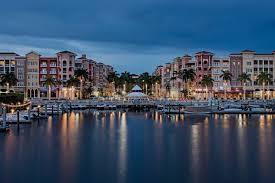


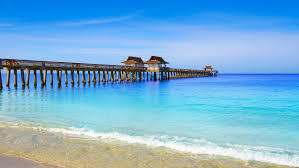
Moving To Naples Florida
Once numbering as many as 10,000 people, the Calusa were ruled by a single chief, supported a nobility and strong military force, dug canals, built huge mounds of shell and earth for their temples and important buildings, and collected tribute from towns and villages reaching all the way across southern Florida to the Atlantic.
Known as the Paradise Coast, Collier County has more than 30 miles of sandy white beaches. Once, the only people to stroll Naples' seven miles of white, sandy beaches, were the Caloosa Indians. Collier County had grown from 85,971 residents in 1980 to 251,377 residents in 2000—and to 322,739 by 2010.
The Naples area is home to several major land reserves, including the Corkscrew Swamp Sanctuary, Everglades National Park , Big Cypress National Preserve , Florida Panther National Wildlife Refuge, Ten Thousand Islands National Wildlife Refuge, and Picayune Strand State Forest The Corkscrew Swamp Sanctuary is known not only for its 11,000 acres (45 km2) of landscape and wildlife, but for a two and a half-mile long boardwalk winding through the sanctuary.
Because of its vast areas of undeveloped preserve lands, Collier County is the primary habitat for the severely endangered Florida panther(Florida's state animal), which roams through the Florida Panther National Wildlife Refuge, Big Cypress National Preserve, Everglades National Park, the Fakahatchee Strand Preserve State Park, Ten Thousand Islands National Wildlife Refuge and Collier-Seminole State Park.
The Gulf Coast portion of the Everglades is the only place on earth where alligators and crocodiles cohabitate and is also home to North America's largest continuous mangrove forest. According to Smart-Zip, there are 78 golf courses in Collier County—one for every 4,418 residents.
Choose from charming beach cottages, towering beachfront condominiums, custom architectural masterpieces, contemporary single-family homes, condos, villas, carriage and town homes in gated, master-planned communities; expansive horse farms, and manufactured homes.
The 729,000 acre preserve allows more recreational activities than a National Park, such as hunting and off road vehicle use. When considering living in Naples you may be wavering between the Gulf Coast and the East Coast of Florida. The Second List: Here's a typical Pro Con list from someone who's lived in Florida a few years or longer and the honeymoon is over because they know what living in Florida is really like (for them).
The area's unrivaled sport fishing, hunting, boating, sun bathing, and beach combing attract people today just as it did a century ago. Hikers taking ranger-guided swamp walks in Big Cypress National Preserve and Fakahatchee Strand Preserve State Park are often surprised by the relatively pleasant conditions in the area's cypress swamps.
Naples (as well as much of Florida) is made up of retirees who don't have kids in school and don't support politically the schools, especially issues that impact taxes. Naples along with the Everglades and Marco Island are known as the Paradise Coast. College choices include Hodges University and Florida South-Western State College (formerly Edison State College), which are in town, as well as Florida Gulf Coast University, which is just a 30-minute drive away.
Several cottages were built by Haldeman and a lot of his early guests were his employees or friends. Some of the best beaches in the county include Naples beach with its iconic pier stretching 1,000 feet into the Gulf of Mexico and Barefoot Beach Preserve which was ranked #2 on Dr. Beach's Top Ten USA Beaches for 2015.
There are approximately 100 art galleries in the greater Naples area, extending from Gallery Row in downtown Naples all the way out to the Big Cypress Gallery in the Everglades - the studio of famed black and white nature photographer Clyde Butcher, known as the Ansel Adams of the Everglades” for his stunning, large format black & white Everglades landscapes.
The world class Artis-Naples, home to the Naples Philharmonic Orchestra and concert hall and the Baker Museum of Art, has helped put Naples on the map as a premiere cultural destination, as have the area's many nationally recognized art festivals. Specific schools, yes, but the school system in general has a poor reputation-especially comparing it to the NE or MW. No one moves to Florida for the schools.
And housing … $350,000 will buy you a spacious three-bedroom, two-bath, pool home with a lake or golf course view in Naples, but it will barely afford you a one-room, closet-sized apartment in Manhattan, a cozy two-bedroom condo in Chicago , plus you'd have to shell out an additional $30,000 for a parking spot, or a 1960s, two-bedroom ranch with about 1,000 square feet of living in Napa, California.
Naples Florida is a tropical paradise with its sugar sand beaches fine dinning and fine art scene. This makes Naples a magnet no many seeking that tropical sun soaked lifestyle. Many Florida Moving Companies offer their biggest discount during off peak season which is October - March so plan accordingly.
8 notes
·
View notes